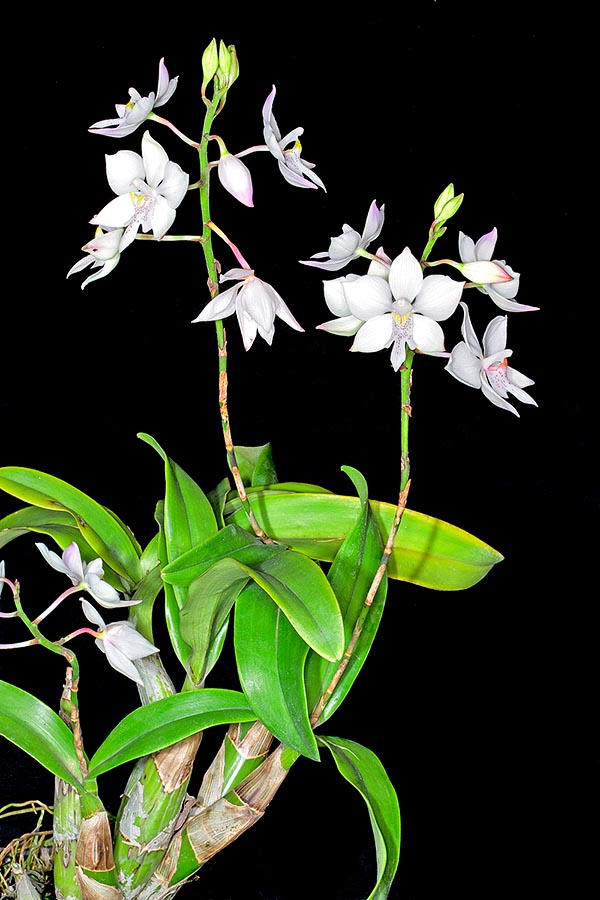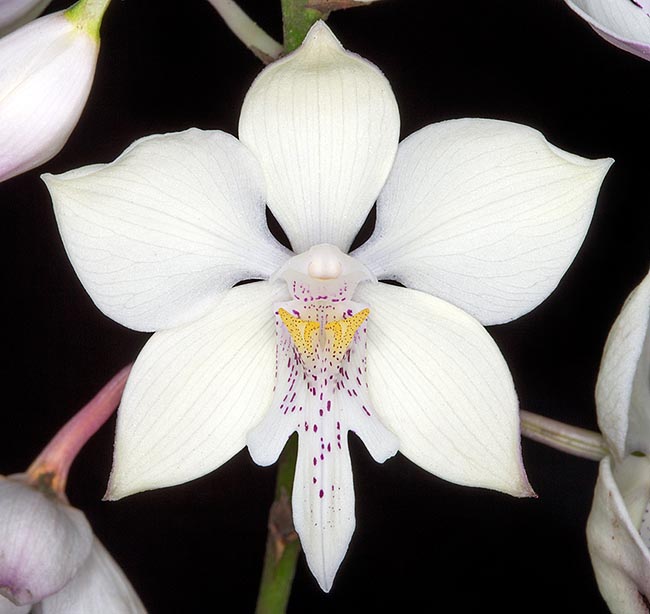Family : Orchidaceae

Text © Pietro Puccio

English translation by Mario Beltramini

The Caularthron bicornutum is usually an epiphyte species, lithophyte at times, with fusiform pseudobulbs that may be even 30 cm long. The oldest, hollow with a small opening at the base, are often infested by ants with whom they live in perfect symbiosis in the humid forests of tropical America © Giuseppe Mazza
The name of the genus is the combination of the Greek substantives “καυλός” (caulόs) = caulis, stem, and “ἄρθρον” (arthron) = articulation, joint, with reference to the prominent nodes of the pseudobulbs; the specific name is the combination of the Latin adverb “bis” = twice and of the adjective = horny, hence equipped with two horns, with reference to the two fleshy ougrowths at the base of the labellum.
Common names: Virgin Mary, virgin orchid (English).
The Caularthron bicornutum (Hook.) Raf. (1837) is usually an epiphytic species, lithophytic at times, with fusiform pseudobulbs, 10-30 cm long and of 2-6 cm of diameter, the oldest ones being hollow with a small opening at the base, often infested by ants with whom they live symbiotically, provided at the apex of 2-4 oblong leaves, 6-20 cm long and 2-4,6 cm broad, coriaceous.
Terminal racemose inflorescences, usually erect, 20-50 cm long, bearing 6 to 20 flowers, on an about 4 cm long pedicel, that gradually open for some weeks, of 5-7 cm of diameter, waxy, with pure white sepals and petals and white labellum with small purple spots, pleasantly scented.
Ovate-lanceolate sepals with more or less pointed apex, 2,5-3 cm long and about 1,6 cm broad, and ovate petals with pointed apex, 2,2-2,8 cm long and about 2,2 cm broad.
Trilobed labellum, 2,2-2,8 cm long and 1,5 cm broad, with lanceolate central lobe with pointed apex and oblong-ovate lateral lobes with rounded apex, provided at the base of two fleshy growths (calli) of yellow colour, erect, triangular with obtuse apex, white column with purple spots, 1,5-2 cm long, and anther with four yellow paired pollinia.
It reproduces by seed, in vitro, and by division with each section provided of at least 3-4 pseudobulbs. Species of easy cultivation known for the beauty of its flowers of pure white colour, often utilized in the hybridizations, to confer this characteristic, requires high luminosity, even full sun, or slight shade, medium-high temperatures, with winter lowest night temperatures not under the 15 °C, high humidity, 70-85%, and constant ventilation.

The candid sepals can be 3 cm long. The labellum is trilobed with showy pointed central apex. The scientific name "bicornutum", given to the species, refers to the two yellow fleshy growths at the base of the labellum © G. Mazza
It may be cultivated in pots or baskets utilizing a draining compound and particularly aerated, so to allow the roots to quickly dry up, being rather sensitive to the stagnant humidity cause of dangerous rottennesses, that can be formed by medium sliced fragments of bark or of coir.
Alternatively, it can be mounted on bark, trunks, cork or arborescent ferns roots rafts.
It does not like to be disturbed, therefore divisions and transplants are to be done when strictly necessary by the vegetative restart, signaled by the appearance of the new roots.
The species is reported in the appendix II of the CITES (species whose trade is internationally ruled).
Synonyms: Epidendrum bicornutum Hook. (1834); Diacrium bicornutum.
→ For general notions about ORCHIDACEAE please click here.
